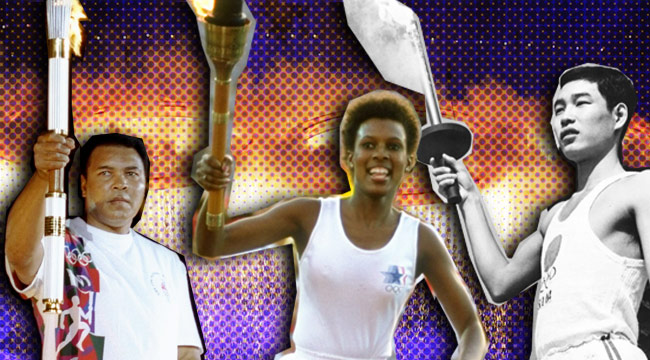
Since late May, Rio de Janeiro has been preparing for its Olympic Opening Ceremony, with three film directors, producers, choreographers, and more than 6,000 volunteers working together before their performance on August 5. In the 120 years since the Games were resurrected by Pierre de Coubertin, they’ve become almost entirely about athletics, but Coubertin’s vision for artistry can still be seen in the formal traditions and artistic expressions that represent the country hosting the Olympic Games and those that participate. Here’s a look back at how these Ceremonies have evolved over the years, and become a defining element of the Games themselves.
Back in 1896, first modern Olympics were held in a single stadium in Greece. It was overflowing with more than 80,000 attendees. The Opening Ceremony consisted of a declaration by Greece’s Head of State as the host nation, along with a performance of the Olympic Hymn, which was performed by nine bands and 150 choir singers. The Hymn, composed by musician Spyridon Samaras with words by Kostis Palamas, wouldn’t return to the Olympics for another 64 years, after it was made the official anthem in 1958, and was played again at the 1960 Olympics, as well as every Olympics since then.
Four years later in Paris, the 1900 Olympics were under-promoted and under-attended as part of the 1900 World’s Fair. Unlike the stateliness of 1896, the Games were secondary to the Fair, and the events were spread out over the course of five months. There were no opening or closing ceremonies at all, and athletes didn’t receive any medals for their achievements. Some were unaware they were even competing in an Olympic event at all. It was, however, the first Olympics that allowed women to compete, and the only one in history to use live animals for its shooting events. The lack of ceremony would continue into the 1904 Games in St. Louis, again overshadowed by the World’s Fair, with less than half of the events involving athletes from outside the U.S.
It wasn’t until 1912, when the Games were held in Stockholm, that the idea of the host country providing the Opening Ceremony was reinstated. That year, a team of Swedish Gymnasts paraded around the stadium, with Swedish King Gustav V commemorating the start of the Games. The effort to establish these traditions was derailed in 1916 by the first World War, which forced the Olympics to be canceled.
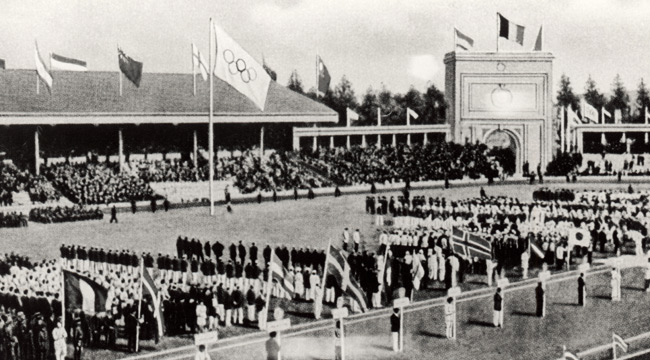
In 1920, however, the Opening Ceremony started to resemble the ones we see today. That year, the Olympics were awarded to the city of Antwerp to honor their suffering during WWI. Several countries were not invited to participate, including Germany, Austria, Bulgaria, Hungary, and Turkey — all Belgium’s enemies during the war. The 29 countries that were allowed to take part saw the start of several new Olympic traditions, including Athlete’s Oath which was given by an athlete from the host country and recited on behalf of all athletes participating. It was also the first time the iconic Olympic flag was flown, featuring the five interlocking circles representing the five continents, with colors selected from every country’s flag in the world that we know today.
The newly-established Athlete’s Oath would change a bit by the 1924 Games in Chamonix, France. That year the Oath was led by French athlete Camille Mandrillon, with participants from every country standing in a circle. Four years later, at the 1928 Games in Amsterdam, the Olympic Flame would be lit for the first time. While there wasn’t an Olympic Torch at this point, the fire was lit inside a cauldron, then raised atop a tower designed by Dutch architect Jan Wils.
Despite the Games having the worst turnout since 1904, the 1932 Opening Ceremony in Los Angeles was an unabashed success. Held at the Coliseum Olympic Stadium, nearly 100,000 people showed up to watch, making the Ceremony itself a major draw of the Olympic Games for the first time. Four years later, the 1936 Games, hosted by Berlin at the height of the Third Reich, wanted to connect the modern-day Olympics with its historic roots. As a result, an Olympic torch was lit in Olympia, then ran through seven countries to its place at the stadium in Berlin. While establishing an important tradition, it also fit the Nazi’s propagandist narrative that the German Reich was descended directly from the classical Greece. Adolph Hitler delivered the speech that opened the Games that year.
Because of WWII, the Olympics wouldn’t resume again until 1948, when London was called upon to host the Games and rose to the occasion despite a rationing of supplies still going after three years of peace time. Like Belgium in the wake of WWI, the Opening Ceremony was given as a testament to the spirit of resilience and togetherness and included the newfound tradition of the Olympic Torch. The Opening Ceremony and the Games that followed were broadcast live on BBC TV for the first time.
There wouldn’t be another noteworthy alteration until 1956, the year the Olympics were held jointly in Melbourne, Australia and Stockholm. Up until this point, athletes had entered the Opening and Closing Ceremonies alphabetically by National Olympic Committees. It was then suggested by an Australian named John Ian Wing that all the athletes enter the stadium together as a symbol of global unity, although this change only affected the Closing Ceremonies, it has remained a part of Olympic tradition to this day.
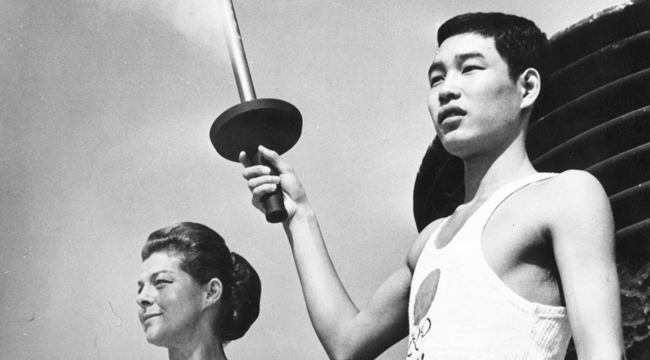
In 1964, Tokyo was selected to host the Olympics in an effort to show how far a country had come after being devastated by war. That year, the Olympic torch was carried through Turkey, Lebanon, Iran, Pakistan, India, Burma, Thailand, Malaysia, Philippines, Hong Kong, and Taiwan. The final torchbearer, Yoshinori Sakai, was born in Hiroshima on the very day that the U.S. dropped the atomic bomb.
As the Olympic Torch has remained a central element to the Ceremonies, it has also been central to representing the culture of the Games’ host country. For example, in 1968, the journey of the Torch recreated Columbus’ journey to the Americas, starting in Olympia, then going to Italy, Spain, San Salvador Island, and the Bahamas before ending in Mexico.
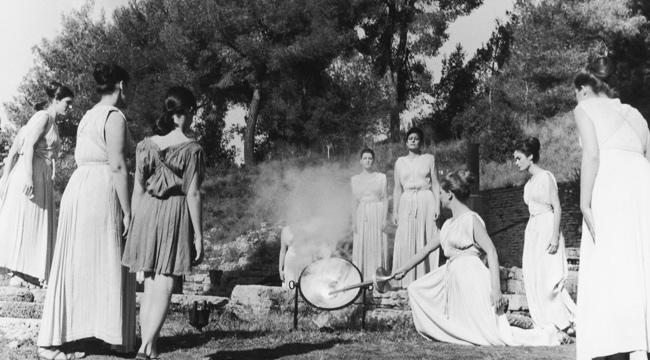
By 1976, the Opening Ceremony had become an event unto itself, and nearly a billion people around the world (roughly one-quarter of the globe at the time) tuned in to watch it on live TV. That same year, the Opening Ceremony featured a troupe of 80 dancers dressed in white to mark the 80th anniversary of the modern Olympic Games. It was also the first time that there were two final torchbearers, 15-year-olds Stéphane Préfontaine and Sandra Henderson, who were chosen to represent the country’s linguistic heritage. Both the Athlete’s Oath and the Official’s Oath were recited in both English and French.
Moscow, the host city of the 1980 Games, pulled off the most elaborate Opening Ceremony yet, lasting several hours with numerous dance numbers rooted deep in Russian tradition. Keeping with the theme of national individualism, the 1984 Games, held for the second time in Los Angeles, had an Opening Ceremony lasting more than three hours. It included a theme song written by Star Wars composer John Williams (who later would win a Grammy for his efforts) and blues singer Etta James’ performance of “When the Saints Go Marching In.” For the Closing Ceremonies that year, Lionel Richie performed a nine-minute version of “All Night Long,” but only after the UFO showed up.
In 1988, when Seoul, South Korea was hosting the Games, many of the doves that were released were killed or badly wounded by the lighting of the Olympic cauldron, and the tradition would come to an end after the 1992 Games. The Ceremony itself included a massive Tae Kwon Do demonstration, as well as a team of skydivers who formed the five Olympic Rings while descending over the stadium. It was also be the last Opening Ceremonies ever held during the day.
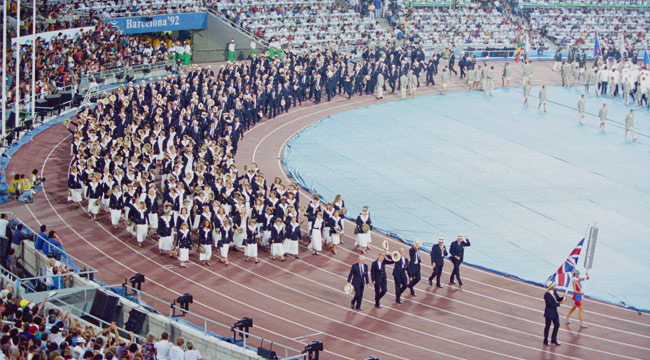
Four years later, after two decades of various Olympic boycotts from countries all over the globe, the world once again came together to participate in a unified Olympics in 1992. The highlight was Olympic archer Antonio Rebollo, who shot a flaming arrow to light the Olympic Torch. In 1996, Muhammed Ali, who passed away earlier this year, lit the torch during the Opening Ceremony — an unforgettable moment that almost didn’t happen. It was his second Olympic appearance, his first being at the 1960 Games held in Rome.
When the Games returned to Athens in 2004, the Opening Ceremony was one of the most celebrated in Olympics history. A lush, elaborate ordeal that harkened back to the Olympics’ roots in ancient culture, and was packed full of Greco-Roman mythology. It was accurate to the point that NBC had to pixelate or crop out the nudity of certain performers to avoid fines by the FCC (though it remained unedited in every other country in which it was broadcast).
After the Parade of Nations, native Icelander Bjork sang “Oceania,” a song she and poet Sjón had written specifically for the Opening Ceremonies. As the song concluded, the cloth of her dress began to unfurl over the heads of the competing athletes at the center of the stadium, which eventually revealed a massive, 10,000-square-foot cloth map of the world.
https://youtu.be/JsDY1Ha83M8
While the 2004 Opening Ceremony was a spectacle to behold, in 2008, Beijing put on the most massive, costly, and jaw-dropping Opening Ceremonies in Olympic History. Starting with almost 14,000 participants with many spending more than a year practicing for the occasion, the total cost ended up around $100 million. The Ceremony itself was a brilliant mix of cutting-edge technology and ancient Chinese cultural symbolism. The torch was lit by gymnast Li Ning, who was suspended by wires and made to look like he was running up a vertical wall to the Olympic cauldron.
For as impressive a feat as it was, it wasn’t without its incidents, though. The lead dancer, Liu Yan, fell from a three-story platform during rehearsal, injuring her spine and paralyzing her from the waist down. Zhang Yimou, the Ceremony’s artistic director, said later that his heart was “full of regrets,” over Yan’s accident, calling her a heroine, and praising the sacrifice she gave for the Olympic Games. Yan still appeared in the program as the event’s lead dancer. In addition, the Ceremony’s “footprint fireworks,” were also computer-generated for broadcast. While they appeared in real life over the stadium, officials felt trying to capture the footage via helicopter was too dangerous.
Nevertheless, the Ceremony received near-universal praise, with everyone from the President of the IOC to Steven Spielberg lavishing praise on it. In doing so, it set the new high-water mark for the Olympic Opening Ceremony.
In London for the 2012 Games, director Danny Boyle named the Ceremony Isle of Wonder. Knowing he wouldn’t be able to top the Beijing opening, and armed with less than half the budget, he opted for a more intimate, personal affair, saying that “there has to be a modesty… and you can’t get grandiose with this job because you are following Beijing.”
A uniquely British endeavor, the Ceremony included cameos from the likes of David Beckham, Daniel Craig as James Bond, and Rowan Atkinson doing a surprise appearance as Mr. Bean. The soundtrack, played throughout the celebration, included songs by The Beatles and David Bowie, among many others, as well as a live performance by Paul McCartney. Overall, it was a resounding success, being called “cynicism-squashingly charming” and “a love letter to Britain” by critics. The ceremony concluded with the tradition of the passing of the Olympic Flag, done by then-London Mayor (and current Brexit enthusiast) Boris Johnson to Eduardo Paes, mayor of Rio de Janeiro.
With the 2016 Olympics right around the corner, Rio looks to follow in Boyle’s footsteps, creating a uniquely cultural event, and will be doing so with a budget roughly one-tenth of what was spent on London’s scaled down Opening Ceremony. Keeping with the traditions of what the Opening Ceremony has come to symbolize, Brazilian Sports Minister George Hilton has promised a show brimming with cultural diversity, and that the Ceremony “will blend the elements together and I believe the show will be wonderful.”
While Rio certainly has a monumental tradition to live up to, the cultural traditions and unique global perspective of the host nation has always been what’s made the Opening Ceremonies such a special event. However they choose to represent themselves to the world that will be watching, it’s certain to take a rightful place in the forever-evolving history of the Olympic Games.
